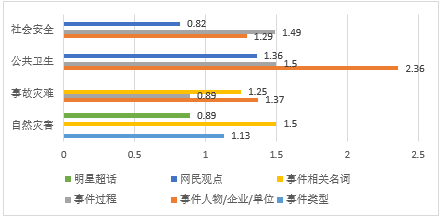 PDF(1148 KB)
PDF(1148 KB)


 PDF(1148 KB)
PDF(1148 KB)
 PDF(1148 KB)
PDF(1148 KB)
突发性公共事件微博舆情中热点网民关注偏好研究
A Study on the Focus Preferences of Hot Netizens in Public Opinion on Weibo of Unexpected Public Events
[目的/意义]旨在通过对热点网民微博词汇频率进行量化处理,总结其在突发性公共事件中的关注点,以实现在舆情防控与治理方面找到新的突破口。[方法/过程]通过爬取微博热点网民的微博数据,利用Word2vec向量模型和TF-IDF权值算法得到热点网民微博词云图中的词类、词性占比和词汇相似比等指标,最后对自然灾害、事故灾难、公共卫生事件和社会安全事件的指标进行汇总分析。[结果/结论]在突发事件舆情中,热点网民对包括事件人物、事件名称和事件过程在内的事件基本组成部分较为关注,且4类突发性事件舆情中热点网民的关注指向性均表现出差异且较为分散,但仍存在共性。同时,通过分析热点网民词云图发现了明星超话、传播能量层级化以及相似度极端化等传播现象。
[Purpose/significance] The purpose of this paper is to find a new breakthrough in the prevention and control of public opinion by quantifying the vocabulary frequency of hot netizens' microblog and summarizing their concerns in public emergencies.[Method/process] In this study, by crawling the microblog data of hot Netizens, word2VEC vector model and TF-IDF weight algorithm were used to obtain the indexes such as the proportion of part of speech and the similarity ratio of words in the cloud map of hot Netizens' microblog words, and finally the indexes of the four kinds of events were summarized and analyzed. [Results/conclusion] In the public opinions of emergencies, the hot netizens pay more attention to the basic components of events, including the event person, event name and event process. Moreover, in the public opinions of the four types of emergencies, the hot netizens show different and dispersed attention directivity, but there are still some commonalities. At the same time, through the analysis of the hot internet users' word cloud map, we found that the star hypertalk, the dissemination of energy hierarchy and extreme similarity and other dissemination phenomena.

sudden public events / public opinion on Weibo / hot internet users / focus on preferences
| [1] |
中华人民共和国国务院.中国人民共和国突发事件应对法[Z].北京:国务院,2007.
|
| [2] |
张一文.突发性公共危机事件与网络舆情作用机制研究[D].北京:北京邮电大学,2012.
|
| [3] |
中国互联网络信息中心.第43次中国互联网络发展状况统计报告[EB/OL].[2019-04-20].http://www.cnnic.net.cn/hlwfzyj/hlwxzbg/hlwtjbg/201902/t20190228_70645.htm.
|
| [4] |
周金元,张莎莎,刘桂锋,等.国内微博研究综述[J].情报杂志,2013,32(9):46-51.
|
| [5] |
王艳.民意表达与公共参与:微博意见领袖研究[D].北京:中国社会科学院,2014.
|
| [6] |
李晓黎.Web信息检索与分类中的数据采掘研究[D].北京:中国科学院计算技术研究所,2001.
|
| [7] |
方洁.微博舆情利益相关者的分类及行为动因研究[D].南京:南京大学,2014.
|
| [8] |
杨延圣.微圈与微圈舆情解析[J].情报杂志,2017(4):146-149.
|
| [9] |
段峰峰,朱娟.微博舆情传播要素空间重构及互动关系[J].新闻传播,2018(23):4-6.
|
| [10] |
超话.秀目网[EB/OL].[2020-04-20].http://www.xiumu.cn/question/6480.html.
|
| [11] |
李丹.公民社会视角下中国微博舆情的发展与走向[J].东南传播,2011,81(5):6-8.
|
| [12] |
饶元.舆情计算方法与技术[M].北京:电子工信出版集团,2016.
|
| [13] |
王国华.突发事件网络舆情的动力要素及其治理[M].武汉:华中科技大学出版社,2017.
|
| [14] |
文晴.微博自然灾害舆情传播要素及网络结构研究[D].长春:吉林大学, 2018.
|
/
| 〈 |
|
〉 |